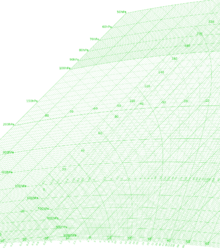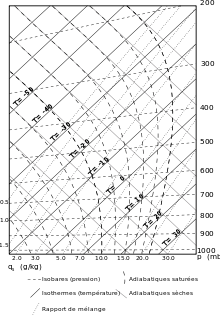Tephigram


A tephigram is one of four thermodynamic diagrams commonly used in weather analysis and forecasting. The name evolved from the original name "T--gram" to describe the axes of temperature (T) and entropy () used to create the plot.[1] Usually, temperature and dew point data from radiosondes are plotted on these diagrams to allow calculations of convective stability or convective available potential energy (CAPE).[1] Wind barbs are often plotted at the side of a tephigram to indicate the winds at different heights.
Description
The tephigram was invented by Napier Shaw in 1915 and is used primarily in the United Kingdom and Canada.[2] Other countries use similar thermodynamic diagrams for the same purpose however the details of their construction vary. In the tephigram, isotherms are straight and have a 45 degree inclination to the right while isobars are horizontal and have a slight curve. Dry adiabats are also straight and have a 45 degree inclination to the left while moist adiabats are curved.[1]
The main reason that tephigrams are used by the British Met Office, the Meteorological Service of Canada, and Met Éireann (Irish Meteorological Service) is the property that areas contained by the curves have equal energies for equal areas, leading to better comparisons of CAPE and hence convective systems.[1]
See also
- Thermodynamic diagrams
- Skew-T log-P diagram, a variation of the Emagram
- Stüve diagram
References
- 1 2 3 4 Meteorology and Climate Centre. "The Tephigram" (pdf). M.Sc. in Meteorology. University College Dublin. Retrieved January 18, 2012.
- ↑ Hoeh, Matthias (13 March 2006). "Heat Transfer within the Earth-Atmosphere System" (pdf). Imperial College London. Retrieved January 18, 2012.
Bibliography
- M.H.P. Ambaum, Thermal Physics of the Atmosphere, published by Wiley-Blackwell, April 16, 2010, 240 pages. ISBN 978-0-470-74515-1
- R.R. Rogers and M.K. Yau, Short Course in Cloud Physics, Third Edition, published by Butterworth-Heinemann, January 1, 1989, 304 pages. EAN 9780750632157 ISBN 0-7506-3215-1
- J.V. Iribarne and W.L. Godson, Atmospheric Thermodynamics, 2nd Edition, published by D. Reidel Publishing Company, Dordrecht, Holland, 1981, 278 pages, ISBN 90-277-1297-2, ISBN 978-90-277-1296-7
External links
- Department of Meteorology, University of Reading page about tephigrams including pdfs of blank printable colour and monochrome tephigrams.